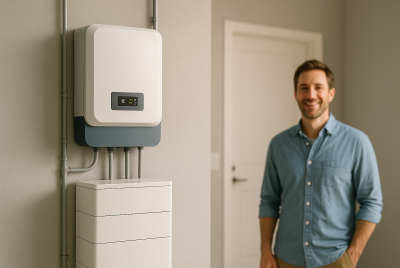EV Charging Cord: Everything You Need to Know
Electric vehicles are becoming more and more popular every day, and if you’re reading this, you might either own an EV or be thinking about getting one. With your new car, you’re stepping into a world of plugs, cords, and chargers. Confused? Maybe a bit, but don’t worry. We’ll walk you through everything and answer any questions you may have regarding EV charging cords, so by the end, you’ll be ready to plug in with confidence.
What Is an EV Charging Cord?
You can think of an EV charging line as the essential connection between your car and its power source. Similar to how a gas automobile relies on a fuel line to operate, your electric vehicle depends on its charging connection. It is in charge of sending electricity straight from a wall outlet or charging station into your car’s battery so you can drive.
Why Are EV Charging Cords Important?
Without a charging cord, your EV’s battery is just a hunk of metal and lithium, waiting to be filled up. Your cord is like a trusty friend who’s always got your back, getting you the juice you need to keep going—whether you’re headed across town or taking a road trip.
Types of EV Charging Cords
There are a few types of EV charging cords out there, and the difference usually comes down to how much power they deliver.
- Level 1 Charging Cords: These plug into your basic household outlet. They’re slower, but perfect for overnight charging at home.
- Level 2 Charging Cords: Faster than Level 1, these connect to dedicated charging stations.
- DC Fast Charging Cords: Usually found at public charging stations, they charge your car in record time—perfect when you’re in a hurry.
How Does an EV Charging Cord Work?
Picture this: the charging station or outlet is a faucet, the cord is a hose, and the electricity is water flowing through it. The power “flows” through the cord into your car, just like water filling up a tank, and voilà—your battery is charged up and ready to roll.
Choosing the Right Charging Cord for Your EV
Here’s a tip: not all cords fit all cars. Different EV models have specific requirements, so before you buy, check your car’s manual or chat with your dealer. It’s like picking the right phone charger—using the wrong one can mean it won’t work or will charge way too slowly.
The Length of Your Charging Cord Matters
Do you think that the cord’s length is irrelevant? Think again about what you assumed! A short cord may be easier to manage, but it may limit your parking options. On the other hand, a longer cord offers more flexibility but could be more challenging to store. If you have a small garage or prefer to park outside, a longer cord can be a solution.
Cord Amperage and Power Ratings
This part is all about speed. Cords come with specific amperage ratings, and the higher the amperage, the faster it’ll charge your EV—kind of like how a firehose pumps out more water than a garden hose. But keep in mind, not every EV is made to handle high amperage. Check your car’s specs before going for the high-powered option.
Indoor vs. Outdoor Charging Cords
Not all charging cords are made for the great outdoors. If you’re planning on charging your car outside, make sure your cord is weather-resistant. Indoor cords can’t stand up to rain, snow, or dust, and they could even pose safety risks if used outside in bad weather.
Safety Features of EV Charging Cords
Let’s talk safety. Good charging cords usually have features like temperature monitoring, surge protection, and automatic shutoff. These help prevent overheating and keep your EV protected from power surges, making your charging experience as safe as possible.
How to Store Your EV Charging Cord Properly
We’ve all been guilty of just shoving a cord somewhere after using it, but with an EV charging cord, proper storage makes a difference. Coil it carefully to avoid tangles, and store it in a dry, cool place. If your car has a special charging compartment, use it! Taking care of your cord means it’ll last longer and perform better.
Common Problems with EV Charging Cords
Charging cords are pretty tough, but they’re not invincible. Here are a few common issues you might run into:
- Overheating: Sometimes caused by improper power flow or damaged cords.
- Plug Fit Issues: A loose fit can mean slower charging or no charging at all.
- Wear and Tear: Over time, frequent use can cause fraying or damage.
Troubleshooting EV Charging Cord Issues
If you hit a snag, don’t sweat it. Here are a few quick troubleshooting tips:
- Cord Won’t Connect Properly: Make sure there’s no debris in the plug or outlet.
- Charging Stops Suddenly: Check for damage and ensure the cord is fully plugged in.
- Overheating Cord: Let it cool down and inspect it before plugging back in.
Extending the Life of Your Charging Cord
Charging cords aren’t cheap, so you’ll want to make yours last. Here’s how to keep it in top shape:
- Avoid Overuse: Only charge when necessary.
- Store Properly: Cool, dry places are best.
- Inspect Regularly: Look for wear and tear before things get worse.
EV Charging Cords and Public Stations
Good news: public stations usually provide their own cords, so you don’t have to bring yours unless you want a backup. However, some stations might have cords that aren’t compatible with your EV, so having your own can sometimes save the day.
Portable Charging Cords for On-the-Go
Ever wish you could just pack up your cord and take it anywhere? Portable charging cords make that possible. They’re a lifesaver if you’re on a road trip or camping and don’t know when you’ll find a public charging station. Just keep in mind, they may charge a bit slower than other cords.
The Cost of EV Charging Cords
EV charging cords range from budget-friendly to premium-priced. And while a cheaper option can be tempting, higher-quality cords generally come with better safety features and are more durable in the long run.
Charging Cords for Apartment Dwellers
If you live in an apartment, charging can be tricky. A longer, portable charging cord might be the perfect solution, especially if you don’t have a designated EV spot or need to reach outlets further away from where you park.
The Future of EV Charging Cords
Imagine a world where you can charge your car wirelessly. It’s possible! But for now, we’re sticking with cords. The good news is, advancements are happening all the time, making cords safer, faster, and more efficient.
Environmental Impact of EV Charging Cords
Did you know some charging cords are made from eco-friendly materials? Opting for a high-quality, long-lasting cord can help reduce waste, which is a small but meaningful way to minimize your environmental footprint.
DIY Tips for Minor Cord Repairs
Got a little fraying near the plug? For minor wear, electrical tape or a protective sleeve can be a quick fix. But if there’s serious damage, don’t risk it—better to replace the cord or consult a professional to stay safe.
“Charging the Future: Challenges and Opportunities for Electric Vehicle Adoption”
This research from Harvard’s Belfer Center examines the hurdles and prospects in EV adoption, emphasizing the importance of efficient charging infrastructure.
“Charging and Discharging Strategies of Electric Vehicles: A Survey”
Published in the journal World Electric Vehicle Journal, this paper systematically classifies various EV charging and discharging strategies, providing a clear definition for each.
“Research on Electric Vehicle Charging System: Key Technologies and Future Development”
This IEEE paper discusses advancements in EV charging systems, focusing on key technologies and future development trends.
Exploring Solar-Powered EV Charging: Related Solar Products and Innovations
Integrating solar energy into electric vehicle (EV) charging is an eco-friendly approach that enhances sustainability. Here are some notable products that facilitate solar-powered EV charging:
- Wallbox Pulsar Plus 40 Amp with Power Meter and UL Enclosure
This bundle includes a 40 Amp Level 2 EV charger, a power meter, and a UL enclosure, enabling efficient solar energy utilization for EV charging. - Emporia Smart 48 Amp Level 2 EV Charger with Home Energy Management System
This charger pairs with the Emporia Vue Energy Monitor to optimize charging sessions based on solar energy production and household energy consumption.
- EVIQO Level 2 EV Charger – 48 Amp
A 48 Amp Level 2 charger compatible with solar energy systems, offering adjustable current settings and smart app integration for efficient charging management. - Enphase IQ 40 Smart EV Charger – 32 Amp
Designed to integrate with Enphase Energy Systems, this charger supports solar energy charging and offers Wi-Fi connectivity for remote monitoring. - Wallbox Power Meter – Smart Home Clamp
This device enables solar EV charging and dynamic load balancing by monitoring household energy consumption, ensuring efficient use of solar power.
These products exemplify the advancements in solar-powered EV charging, providing sustainable and efficient solutions for electric vehicle owners.
Wrapping It Up
Your EV charging cord is way more than just a cord—it’s what keeps your car ready to go, making it one of the most important accessories for any EV owner. Choosing the right cord, taking care of it, and understanding its limits can make charging easy and hassle-free. Now you’re set to plug in with confidence, knowing your EV is ready for the next journey.
FAQs
How do I know which EV charging cord is right for my car?
Check your EV’s manual or ask your dealer to make sure you’re buying a compatible cord.
Can I use any EV charging cord for my vehicle?
Not every cord works with every car. Make sure the plug and power rating match your car’s needs.
How long does an EV charging cord last?
With proper care, a good charging cord can last several years, although usage will affect its lifespan.
Can I repair my charging cord if it’s damaged?
Minor fixes are possible, but for serious damage, it’s safer to replace the cord.
Are portable charging cords safe?
Absolutely, as long as they meet safety standards and are used correctly. They’re great for those times when you need to charge on the go.




